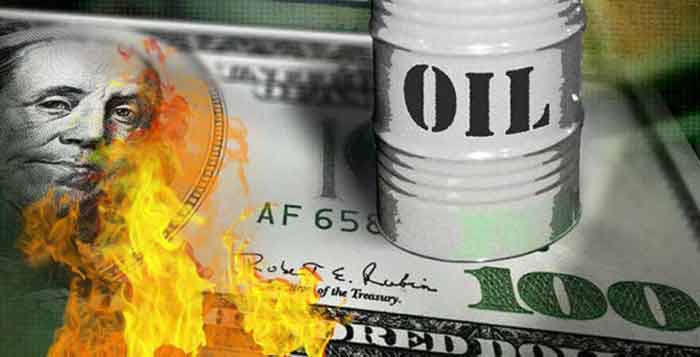US oil and gas affected by international tensions

Now that the battle to acquire Anadarko Petroleum has ended, a host of other key industry news items are percolating up to the top of the page. Let’s review the always-fluid Oil And Gas Situation for mid-May, 2019.
Middle East tensions make a comeback. – Well, actually, these tensions never go away, but this week they are spilling over into headline-making conflicts. Monday morning brought news that two Saudi tankers ships had allegedly been attacked as they traveled near the crucial Strait of Hormuz choke-point in the Persian Gulf. The attack reportedly took place near the Port of Fujairah, and also involved two other vessels, one registered to Norway and the other to the UAE.
The Brent crude price spiked $2.00/bbl in the immediate wake of the report on Monday, but then fell back as the day progressed and the U.S./China trade war resumed domination of the news. But the price spiked again Tuesday morning when news of more alleged attacks on Saudi infrastructure came, this time on several pipeline pumping stations, one in the country’s Eastern Province which caused a disruption of oil flow through a major pipeline. Two other pumping stations in the greater Riyadh region were also attacked, as Yemeni rebels simultaneously took credit for launching what they described as a “coordinated drone attack.”
Although Iranian officials denounced the attacks and Saudi officials expressed doubts of Iranian involvement, CBS News reported that “a team of U.S. military investigators has made an initial assessment that Iran or groups it supports was behind an alleged sabotage attack on 4 tankers in the Gulf of Oman.” President Trump implied to reporters his own belief of Iran’s involvement, saying “it’s going to be a bad problem for Iran if something happens.”
These rising international tensions will likely lead to a new “fear premium” being baked back into crude prices.
The U.S. rig count continues its slow-motion drop. – As has been the case since just prior to Christmas, the DrillingInfo Daily Rig Count keeps falling. The count closed at a 2019-low of 1016 on May 13, down from 1060 a month ago, and from 1160 just prior to Christmas. This is not surprising, and is in fact exactly what we expected at the first of the year, as investors continue to press companies to give more weight to returns on investment than to increasing supply.
But U.S. production keep rising. – Increased efficiencies and higher resource recoveries from each wellbore keeps overall U.S. production levels rising , but the pace of that rise is slower than it was in 2018, when the industry added almost 2 million barrels of oil per day (bopd). Still, the U.S. Energy Information Administration (EIA) raised its outlook for production growth during 2019 earlier this month from its previous 1.43 million bopd to 1.49 million bopd. This would put the industry on a pace to reach the 13 million bopd level during the 4th quarter of this year.
Amazing.
And it keeps getting cheaper. – Five years ago, the knock on U.S. shale oil was that it cost too much to produce. Break-even costs per well at that time were well above $70/bbl in the prime locations and far higher in locations that were not so prime. In the era of $100 oil – before Saudi Arabia flooded the market and collapsed the price, thus forcing a new discipline on U.S. shale producers – U.S. tight oil ranked as the most costly source of new oil production on the planet.
That has all changed now, according to industry analytics firm Rystad Energy. In a report released on May 10, Rystad finds that high cost situation has been reversed, and U.S. tight oil now ranks as the second-least expensive source of new oil on Earth.
“As the majors are struggling to replace conventional liquids, a wealthy source of additional resources is tight oil,” says Espen Erlingsen, Head of Upstream Research at Rystad Energy. “The North American tight oil industry has changed considerably since 2014, as it has proven to be a competitive supply source in a low price environment. While costs for tight oil have been reduced, the resource potential has grown considerably over the last four years.”
That’s what a half-decade’s focus on efficiency and innovation will do for an industry.
Finally, good public policy matters. – As U.S. shale oil has become more plentiful and less expensive to produce, the need to export it in order to be refined has grown apace. In a new report released on May 10, industry solutions provider DrillingInfo says its analysis proves the role of rising exports has been crucial to the expansion.
To emphasize the point, Bernadette Johnson, Vice President of Market Intelligence at DrillingInfo states that “Every incremental barrel of production since the middle of 2016 has been exported. As U.S. crude oil production grows, all incremental barrels are (and will continue to be) exported.”
The Report also emphasizes the growth of U.S. LNG exports: The LNG liquefaction market is the key player for natural gas exports. By the end of 2019, the U.S. will have six operating terminals and nearly 10 Bcf/d of capacity. Additionally, more than 40 Bcf/d and 20 terminals have been proposed in the U.S. However, Drillinginfo analysts expect U.S. LNG exports to reach 10 Bcf/d in 2023, as growth from non-U.S. LNG export facilities drives global LNG prices down.
None of this rapid growth in U.S. exports would have been possible were it not for the December 2015 repeal of the 1970s-era ban on crude oil exports, and the increased pace of permitting for new LNG export infrastructure that has taken place since 2016.
Good public policy matters, nowhere moreso than as it relates to the U.S. oil and gas industry.
Article featured by Forbes

